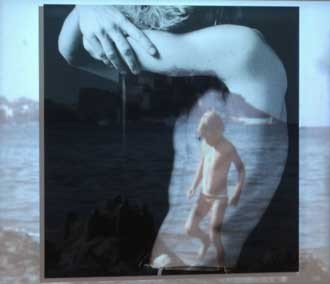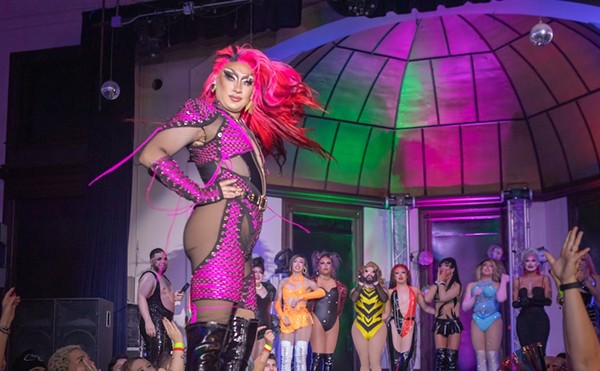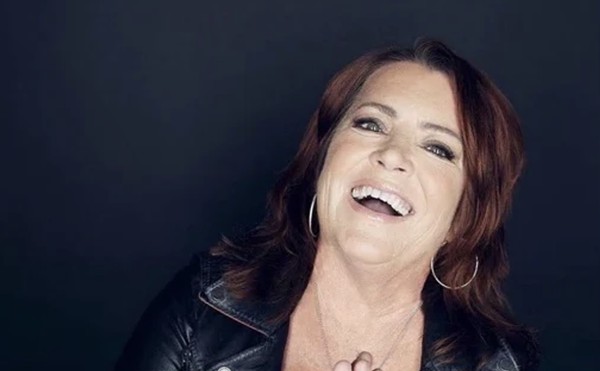Arnoud Holleman turns portraiture into a riddle
In order to create a portrait, Arnoud Holleman often begins with a photograph and then layers film, sound, text, and drawing until he believes he has achieved a significant image. The Dutch artist, whose solo exhibition opened recently in Artpace’s Hudson (Show)Room, is known for co-editing Re-Magazine, a journal about “one person,” in which autobiography is, in fact, a team effort. In his works on view at Artpace, Holleman appropriates imagery and inserts his own story into the stories of others, fracturing the memoir process. It’s enough to cause Oprah to phone Larry King and have James Frey cheering.
| “Willem,” a mixed-media work incorporating video, photography, and sound, is part of Arnoud Holleman’s one-man show in Artpace’s Hudson (Show)room. |
Holleman’s 2003 floor-to-ceiling video, “Staphorst,” reaffirms the power of video, a medium diluted by too many mind-numbing transmissions. The artist re-edited a piece of vintage film shot in 1959 in the rural, and devoutly Protestant, Dutch village of Staphorst. One of many movie trailers touting post-World War II progress, the film’s production defies comprehension. The community’s religious dogma rejected “graven images,” including the villagers’ portraits, and cameras are aimed like guns at cherubic children in bonnets and wooden shoes as they pedal bicycles and play in the streets. As though attacked by the camera’s eye, the youngsters duck their heads, turn away, and run, now in slow motion, heavy in their blown-up proportions thanks to Holleman.
The film is cruel, but beautiful. It raises questions about the rights of documentarians versus those who claim religious privacy. It would read politically if it were filmed today in an Islamic community with the same strict code. As it is, these adorable children look like they are playing hooky from the front of paint cans and must surely want to be filmed as many of us wanted to star in home movies.
Black-and-white cinematography and a slow pace smear the children’s images on celluloid like cheek swabs on a petri dish — the citified cameramen were taking a sample “culture.” Existentialist philosopher Jean-Paul Sartre believed the gaze makes us uncomfortably self-conscious. We despise people for seeing, hearing, and, most importantly, judging us, but the reflection of ourselves in their eyes is what proves that we exist.
While “Staphorst” has been altered, it remains a single-layer silent film. Other works by the artist are denser, but the layering, while interesting, doesn’t outdistance the power of “Staphorst.” In “Marcel,” Holleman projects a photo of his friend over film Marcel shot of heroin addicts shooting up in his alley — the face behind the camera is now simultaneously in front. The soundtrack weaves Marcel talking about the junkies with Holleman’s voiceovers, blending them into one voice that meanders, hallucinatory, like automatic writing. Its successfully sleepy quality mimics the junkies’ stupor.
Two works in particular are achingly beautiful: “Auntie Truus & Auntie Mok” and “Bert Luttjeboer” are named after their portrait subjects. Holleman shamanistically hand-copied photographs, trying to suss out the paradox whereby an instantaneous camera shutter can capture so much detail. Polaroids shown next to the copies pose a reality once-removed. Adding another layer, wall texts in the artist’s voice accompany beguilingly basic images. “Happiness is a bathtub and soft towels,” says one ex-boyfriend rather than admit he has AIDS. The artist sticks to intimate candor as a way of revealing ultimate truths — the likes of which make J.D. Salinger not just relatable, but brilliant.
| Arnoud Holleman Noon-5 Wed-Sun, noon-8 Thu, & by appt. Through Apr 23 Free Artpace 445 N. Main 212-4900 |
Holleman’s “Aunties” aren’t really his aunts but two elderly women (one related by blood) that moved to the big city of Amsterdam when they were young to be career girls and share a flat. They just never stopped sharing that flat. Holleman tells us how, after he came out as a homosexual, he asked Auntie Mok if perhaps she was gay as well. Her answer (which I won’t give away) lifts the curtain just a little on the complexities of being anything but traditional in previous generations. Photographs Holleman took of the two women pushing lawnmowers in the late 1960s are surrounded by a grid of drawings that remind me, in both style and substance, of sunny days captured on painter Fairfield Porter’s veranda in the Hamptons, idyllic scenes of him, his family, and his male lovers and friends in dappled sunlight.
Arnoud Holleman’s work exudes an editor’s sense of reality in black and white, while still managing to be gray all over. His portraiture style makes an interesting addition to the dialogue of recent San Antonio exhibitions, particularly Alice Carrington’s Portrait Show at CAMPsite and the San Antonio Museum of Art’s Retratos: 2,000 Years of Latin American Portraits exhibition now on view. Just when you thought you knew yourself! •















